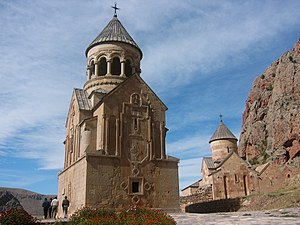Noravank
| Noravank | |
|---|---|

Surb Astvatsatsin and Surb Karapet Churches with Surb Grigor's Chapel to the right, Noravank
|
|
| Basic information | |
| Location | Amaghu Valley, Vayots Dzor Province, Armenia |
| Geographic coordinates | 39°41′03″N 45°13′58″E / 39.684061°N 45.232872°ECoordinates: 39°41′03″N 45°13′58″E / 39.684061°N 45.232872°E |
| Affiliation | Armenian Apostolic Church |
| Architectural description | |
| Architectural style | Armenian |
| Groundbreaking | 1205 |
Noravank (Armenian: Նորավանք, literally "new monastery") is a 13th-century Armenian monastery, located 122 km from Yerevan in a narrow gorge made by the Amaghu River, near the town of Yeghegnadzor, Armenia. The gorge is known for its tall, sheer, brick-red cliffs, directly across from the monastery. The monastery is best known for its two-storey Surb Astvatsatsin (Holy Mother of God) church, which grants access to the second floor by way of a narrow stone-made staircase jutting out from the face of building.
The monastery is sometimes called Noravank at Amaghu, with Amaghu being the name of a small and nowadays abandoned village above the canyon, in order to distinguish it from Bgheno-Noravank, near Goris. In the 13th–14th centuries the monastery became a residence of Syunik's bishops and, consequently. a major religious and, later, cultural center of Armenia closely connected with many of the local seats of learning, especially with Gladzor's famed university and library.
Noravank was founded in 1205 by Bishop Hovhannes, a former abbot of Vahanavank near the present-day city of Kapan in Syunik. The monastic complex includes the church of S. Karapet, S. Grigor chapel with a vaulted hall, and the church of S. Astvatsatsin (Holy Mother of God). Ruins of various civil buildings and khachkars are found both inside and outside of the compound walls. Noravank was the residence of the Orbelian princes. The architect Siranes and the miniature painter and sculptor Momik worked here in the latter part of the thirteenth and early fourteenth century.
The fortress walls surrounding the complex were built in the 17th–18th centuries.
The grandest structure is Surb Astvatsatsin (Holy Mother of God), also called Burtelashen (Burtel's construction) in the honour of Prince Burtel Orbelian, its financier. It is situated to the south-east of the Surb Karapet church. Surb Astvatsatsin was completed in 1339, a masterpiece of the talented sculptor and miniaturist Momik, who designed it, and was also his last work. Near the church there is his tomb khachkar, small and modestly decorated, dated the same year. In recent times the fallen roof had been covered with a plain hipped roof. In 1997 the drum and its conical roof was rebuilt, with the form based on existing fragments. The ground floor contained elaborate tombs of Burtel and his family. Narrow steps projecting from the west façade lead to the entrance into the church/oratory. There is fine relief sculpture over the entrance, depicting Christ flanked by Peter and Paul.
...
Wikipedia
